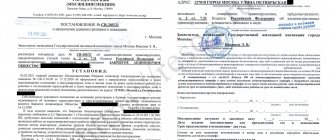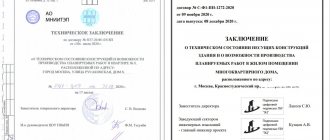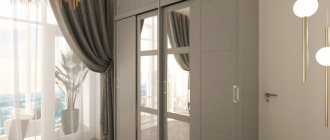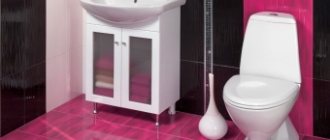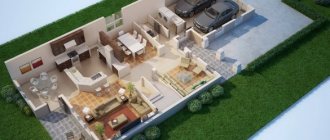Illegal redevelopment - moving the kitchen into the living room (unapproved changes are marked in red)
At the beginning of the article, let's agree on some terms used in it.
Illegal redevelopment of an apartment or non-residential premises is a redevelopment in which the planned or completed work contradicts SNiPs, SanPiNs, regulations and other legal acts, as a result of which it cannot be agreed upon and permission cannot be obtained for it.
Uncoordinated, unauthorized or unauthorized redevelopment is a redevelopment in which the work was carried out without the appropriate permission and approval, but which does not violate construction, sanitary, hygienic and legal standards.
How to legalize illegal redevelopment?
From the definition given above, it becomes clear that it is impossible to coordinate illegal redevelopment. Despite this, we recommend that you send us an email to [email protected] with a request with plans for your illegal redevelopment - perhaps we will be able to come up with something. There are often borderline and complex cases in which the laws can be circumvented with minimal sacrifices. Or you can call us at +7 (495) 507-74-67.
On the contrary, it is possible to legalize unauthorized redevelopment, based on the definition we gave it at the beginning of the article. We have devoted an entire article to this issue, which we recommend that you read. If you want to know the cost of such legalization, then you can also call us on the same phone number +7 (495) 507-74-67, fill out an application or send a request by mail
Prohibited redevelopment
Compliance with legal regulations is strictly for property owners. Any project can be implemented if finances are available, but the possibility of its legalization should be clarified in advance.
Three prohibited options for changing the layout include:
- Moving the toilet to parts of the apartment located above the living quarters of the neighbors below.
- Installation of heated floors powered by central heating.
- Combining a kitchen and a room by equipping the dining area with a gas stove.
Attention! Any connections to common house systems are not legal. Property owners have similar rights to operate an apartment building.
Any actions that threaten the integrity of the house and disrupt the operation of engineering structures are prohibited.
Responsibility for illegal redevelopment of an apartment or non-residential premises.
If you carried out the redevelopment illegally, then it will no longer be possible to legalize it and the repair work will have to be done again, but in compliance with all standards. Therefore, it is better to initially coordinate the redevelopment before repairs and be sure of its legitimacy. Responsibility for illegal redevelopment lies entirely with the owner of the apartment or non-residential premises.
We talked in detail about the fines and consequences of such redevelopment in a separate article, and if you are interested in this issue, we recommend that you definitely read it. However, we will briefly touch on this issue here. Commentary on the video: With the release of Moscow Government Decree No. 1335 of August 19, 2021, which amended PPM No. 508, the following has changed and is relevant for 2021: 1. The construction of a mezzanine is now allowed to be installed not on 40% of the area of the room in which it is located , and according to clause 10.13 of Appendix 1, the sum of the areas of all mezzanines should be no more than 40% of the area of the entire apartment or non-residential premises. 2. Clauses prohibiting the installation of plumbing fixtures and slabs on mezzanines and the installation of bathtubs, toilets and kitchens on them were removed. Now you can do it. It should not be forgotten that the installation of wet areas above living rooms and kitchens is prohibited according to clause 9.22 of SP 54.13330.2016. It is also prohibited to install a kitchen above the living room in accordance with clause 24 of RF PP No. 47. 3. Clause 10.24 has been added, prohibiting the excavation of soil in basements and ground floors. 4. Added clause 10.25, which does not allow the laying of transit communications through adjacent premises when their boundaries are changed. 5. Added clause 10.26, according to which kitchens with a gas water heater must be separated from living rooms by tightly closing doors with a grate or a gap between the doors and the floor of at least 0.02 sq.m. 6. The impossibility of performing work that requires approval for the project in the non-residential premises of the building, which is the property of the city of Moscow, has been canceled;
SanNPiN 2.1.2.2645-10 was cancelled, which prohibited the entrance to the bathroom from the kitchen or room. Now it is possible.
The fine for legal entities was also reduced from 300-350,000 rubles. up to 40-50,000 rub. in case of carrying out repair work without obtaining prior approval in accordance with paragraph 2 of Art. 7.21 Code of Administrative Offenses of the Russian Federation.
Nothing else has changed.
Approximate terms and cost of work
| Actions | Expenses | |
| Time, days | Money, rub. | |
| First contact with BTI | 10-14 | 500 – 1 500 |
| Creation of a package of project documentation | 14-60 | 2 500 – 35 000 |
| Additional permits (SES, Ministry of Emergency Situations, etc.) with the help of specialists | 15-30 | 5 000 – 20 000 |
| Coordination of the demolition of the wall with the local administration | 30-45 | – |
| Secondary application to the BTI, preparation of a technical passport | 10-14 | 1 200 – 4 500 |
| Registration of changes in the Unified State Register of Real Estate | 3-14 | 350 |
What are the consequences of illegal redevelopment of non-residential premises or apartments?
For illegal redevelopment, the owner will face a fine and an order to return the violations to their original state.
Let's consider this issue in more detail. Firstly, according to paragraph 2 of Article 29 of the Housing Code of the Russian Federation, the owner will inevitably face punishment for illegal redevelopment of an apartment or non-residential premises in an apartment building if it is discovered in the form of a fine. In Moscow, for individuals it is 2000-2500 rubles according to paragraph 2 of Article 7.21 of the Code of Administrative Offenses of the Russian Federation, for legal entities - 40-50,000 rubles according to the same article. Secondly, according to paragraph 3 of Article 29 of the Housing Code of the Russian Federation, and in Moscow according to paragraph 3.3.3.8.2.2.2 of the App. No. 2 to the 508th Resolution of the Moscow Government for apartments, the owner of an apartment or non-residential premises with illegal redevelopment is issued an order to return the layout of such an apartment or non-residential premises to its original position in terms of the work that violated the law. In other words, the expensive repairs made will have to be returned to their original position. This order is issued in Moscow by an inspector of the Housing Inspectorate, and in other cities of Russia by the corresponding representative of the local government (according to clause 1. Article 26 of the Housing Code of the Russian Federation). If the inspector is not allowed into an apartment or non-residential premises, he will seek access to them through the court. In this way, the detection of illegal redevelopment can only be delayed. If the unauthorized redevelopment has not been eliminated in accordance with the issued order, then the case is referred to the court, which, in accordance with clause 5 of Article 29 of the RF Housing Code, has the right to put such an apartment or non-residential premises up for sale at auction, which has already happened several times on practice.
2.1. Illegal redevelopment - consequences when affecting load-bearing structures.
Illegal repairs in an apartment or non-residential premises that improperly affect load-bearing structures can lead to even more serious consequences, which we described in detail in paragraph 7 of this article. If you are planning or have affected load-bearing structures during repairs, be sure to familiarize yourself with it.
2.2. What are the consequences of illegal redevelopment of an apartment or non-residential premises?
If the unauthorized redevelopment was carried out without violating the current legislation, then the situation is somewhat better. Responsibility for uncoordinated redevelopment, that is, for redevelopment carried out without the appropriate permission, but not violating legal and construction standards, in Moscow provides for the imposition of fines in the same amounts as described above, as well as the issuance of an order on the need for its approval. That is, according to existing standards, such a reconstruction can be legalized in accordance with paragraph 18 of Appendix 1 of the 508th Decree of the Moscow Government. We have already provided a link to an article describing this process at the top. To the question of what kind of redevelopment generally requires approval, we answered here. In the Moscow region, however, local government bodies do not provide for the approval of such redevelopment. They demand its legalization through the court in accordance with clause 4 of Article 29 of the RF Housing Code.
In the vast majority of cases, it is extremely rare to independently carry out the redevelopment of an apartment or non-residential premises without violations, since in our country there are a large number of prohibiting regulations and building standards in relation to its implementation, which we will discuss below. Even if the redevelopment was carried out without violations, then the Housing Inspectors of many districts, in order to legitimize it, require the provision of BTI plans for an apartment or non-residential premises showing the layout changes that have already been made (the so-called “red lines”, which we will discuss below), that is, “ show it to the technical registration authorities even before receiving official permission. In this case, you need to be absolutely sure of the legality of such unauthorized redevelopment, which even experienced specialists cannot always guarantee, since certain cases of redevelopment that are borderline from the point of view of the law can be interpreted by them differently. Otherwise, you will get an unpleasant situation when it was not possible to legitimize the changes made in the layout, but they are already reflected in the BTI plans and you can’t just return them back. Even if the Housing Inspectorate does not require the provision of BTI red line plans for the new layout, then, as mentioned above, the inspector may still find any violations during its inspection and will then issue an order to return the repair to its original state. It should also be noted that the Housing Inspectorate immediately reviews submitted documents for legalization of already completed redevelopment for about three months, while they review documents for the planned layout within a month.
As follows from the above, the consequences of unauthorized reconstruction and redevelopment of an apartment or non-residential premises can be very unpleasant, and therefore it is better to coordinate such work before carrying out repairs. Or at least consult relevant specialists before doing this.
The cost of approval of a sketch in APM-1
A redevelopment sketch costs 5,000 rubles. Turnkey approval – from 50,000 rubles. This price includes:
- preparation of all documents, including obtaining an archival plan of your apartment;
- calling a BTI technician, after which we will double-check whether he took the measurements correctly and whether he correctly marked the changes with red lines;
- let's make a sketch;
- We will call an engineer from the Moscow Housing Inspectorate and accompany him;
- We will receive a certificate of completed work and a new plan of your apartment, and we will send you new documents by courier.
If you want to coordinate everything yourself, be sure to contact us so that we can tell you what needs to be taken into account so that you avoid BTI errors, and nothing unnecessary appears on your apartment plan after measurements.
How is illegal redevelopment of residential and non-residential premises detected?
Unauthorized and uncoordinated redevelopment of non-residential premises or apartments can be detected in several cases:
- a complaint was received about illegal redevelopment from neighbors due to noise from renovation work, poor sound insulation, personal hostility, and so on;
- when touring the apartment or supervising the management company, if it submits an application for illegal redevelopment to the relevant authorities;
- when the BTI technician leaves;
- for non-residential premises during an unscheduled inspection by the Housing Inspectorate in Moscow;
If the illegal redevelopment has not been identified by the approving authority (the Housing Inspectorate for Moscow or the local government body for the Moscow region) and is not included in the inventory plans (not shown on the BTI plans), then it can be returned to its original position without any instructions. If it does not have any legislative violations (that is, according to the terminology we have adopted in this article, it is simply an unauthorized redevelopment of an apartment or non-residential premises), then it can be approved as soon as it is planned (in other words, retroactively), while saving money and without “highlighting” it in the BTI plans. In this case, it will also be possible to avoid punishment for illegal redevelopment in the form of a fine.
If unauthorized reconstruction of housing cannot be agreed upon
If such violations are identified that it is no longer possible to legitimize an unauthorized change in the layout, the inspector will issue an order to return the premises to its original form. Sometimes it is almost impossible to fulfill such an order. So, if during the repair a load-bearing wall was affected, in which, for example, an opening was made, then returning it to the “as it was” position may not only be impossible, but also unsafe.
In such complex cases, a separate project is developed, which is carried out by firms with experienced housing staff. Note that the development of such a project is an expensive procedure, as is the restoration work itself, and it is clear that all these costs will be borne by the owner, who ignored the approval procedure.
When the owner refuses to legalize the redevelopment, the Housing Inspectorate has the right to sue him. According to Russian laws, a tenant can be evicted from an apartment only on the basis of a court decision. If the Housing Inspectorate goes to court with a claim, the owner of the property faces the forced sale of the residential premises at an auction price, termination of ownership and collection of the cost of restoration work. In practice, such cases are rare, but it is still worth knowing about the possibility of such consequences.
Illegal redevelopment of an apartment - where to go?
If you want to legitimize illegal redevelopment, that is, repairs carried out in violation of the law, then you will not be able to do this and for this it is better not to go anywhere at all, so as not to “shine it” once again. Unless, as we have already said, you can call us and perhaps we can come up with something to coordinate it.
If you want to legalize unauthorized redevelopment, that is, repairs carried out without violating all laws, then you must contact the Housing Inspectorate if the property is located in Moscow, or the local government body (Administration) if in the Moscow region. However, we strongly recommend that before this you at least simply consult with specialists about your completed redevelopment, so as not to “expose” its possible inconsistencies with construction and legislative standards.
If you want to know where to report illegal redevelopment of your neighbors, we will talk about this below.
How to avoid punishment or reduce it
The best way to avoid punishment is to act according to the law, that is, agree on the redevelopment in advance. If you proceed in reverse order, you need to be prepared that this is a kind of “lottery”. The court and experts may recognize the possibility of recording the reconstruction in documents, or, conversely, the owner will be obliged to return everything to its original state at his own expense and pay a fine.
To legalize the redevelopment, you need to collect documents, prepare a project and contact the BTI. A special commission will go to the address where the apartment is located, inspect the living space and issue a verdict.
If difficulties arise, please seek legal advice. You can get free legal assistance on our website. in a special window.
Now you know what fine you will have to pay for remodeling an apartment without permission in 2021. To avoid problems, it is necessary to coordinate major repairs in a timely manner. However, if you have already made a redevelopment without approval, you should not despair - contact a lawyer who will help correct the situation with minimal losses.
Where to complain about illegal redevelopment?
A complaint about illegal redevelopment of neighbors is written to the Housing Inspectorate of your administrative district, if the house is located in Moscow, or to the local government body (city or settlement administration), if the building is located in the Moscow region.
A complaint is written in free form on an A4 piece of paper addressed to the head of the Housing Inspectorate of the given district. The header of the complaint must indicate who it came from (full name, passport details and registration address). In Moscow, only the Housing Inspectorate is entrusted with the authority to control illegal repairs in residential apartment buildings. Neither the district police officer, nor the management company, nor the police are responsible for this and it is useless to contact them. The maximum they can do is to write your request for inspection to the same Housing Inspectorate based on your complaint. You can complain about your neighbors’ illegal redevelopment even without being sure whether it was actually done or not. Thus, you simply ask to check this apartment or non-residential premises for the presence of uncoordinated redevelopment. As we already wrote above, in response to this complaint, an inspector will definitely come to an apartment or non-residential premises and provide an answer based on the results of his inspection. If he is not allowed into an apartment or non-residential premises, then he must seek access to the facility through the police or court.
Procedure
The following algorithm is used to demolish walls in an apartment without violating current legislation:
- To make significant design changes, the owner contacts the design agency to prepare a high-quality package of documentation.
- The destruction of non-load-bearing walls and other simple operations can be depicted on the existing plan independently.
- Collect the necessary certificates and confirmations.
- The technical passport received from the BTI and the accompanying documents according to the list are applied to the architectural department of the municipality.
- Obtain official permission to redevelop the apartment (approval for the demolition of a wall).
- Perform work operations.
- They invite a BTI specialist to professionally record the changes made in the work completion certificate (transferred to the register without the participation of the property owner).
- Based on the measurements taken, BTI creates a new technical plan.
- This document is submitted to Rosreestr through the MFC in order to make adjustments to the entries in the database.
Purchasing an apartment with illegal redevelopment.
As we have already said, all responsibility for the illegal redevelopment lies with its owner. Not on the repair and construction team or the designer, but on the owner. Thus, when buying an apartment with illegal redevelopment, you take full responsibility for it. There are even cases when a person bought an apartment without suspecting anything about the redevelopment carried out in it, or the redevelopment was carried out a very long time ago. All the same, in these cases, it is he who is responsible for the unauthorized redevelopment. Therefore, first of all, you need to take a BTI plan for your apartment. It must be in black lines and without a stamp indicating the presence of uncoordinated redevelopment in the apartment. Then the actual layout of the apartment is compared with this plan. If there are any differences, then redevelopment has been carried out.
Before purchasing an apartment with illegal or unauthorized redevelopment, we strongly recommend that you consult with specialists regarding its legality, the possibility and cost of legalization, as well as the possible consequences. To do this, as we have already said, you can send apartment plans to us by email [email protected] or call +7 (495) 507-74-67.
Illegal redevelopment when buying an apartment can be a very unpleasant surprise. It often happens that we are contacted by an owner who bought an apartment with illegal redevelopment with terrible violations, simply without checking it, and now he is forced to answer for it. We have already written above about the possible consequences of such redevelopments.
New
The legislation on redevelopment has not received any major changes this year. Innovations in the coordination of reconstruction were:
- The applicant has the right not to submit a technical passport and an expert opinion from the service involved in the protection of cultural and architectural monuments;
- If the right to an apartment undergoing alteration is registered in the Unified State Register, then there is no need to submit documents confirming such powers.
It should be noted that in addition to the judicial resolution of the issue of illegal redevelopment, it is possible to legalize unauthorized repairs through an administrative procedure established by the local municipality. It consists of obtaining permits for reconstruction work. But this is only possible if the necessary approvals from the relevant services and expert opinions have been obtained.
How to sell an apartment with illegal redevelopment?
Now let's look at the same situation from the seller's side. Selling an apartment with illegal redevelopment is quite difficult. Firstly, it is necessary to find a buyer who will be ready to purchase such an apartment and take full responsibility for the redevelopment. This puts many buyers off. Secondly, if they agree to such a purchase, many buyers demand a discount on it for subsequent legalization services. Thirdly, the buyer must have “direct money” and not a mortgage, since most banks simply do not approve the purchase of such an apartment. Therefore, it is much easier to sell an apartment with an agreed redevelopment. However, it can be done. There are no restrictions from Rosreestr on this issue.
Coordination of dismantling or moving non-load-bearing walls
The following works require official registration:
- partial dismantling of non-load-bearing structures;
- construction of new partitions (for example, arrangement of a dressing room);
- demolition of the wall between the room and the kitchen;
- modifications of load-bearing structures.
If you do not coordinate the redevelopment, this threatens with unpleasant results in the form of problems when selling the apartment. Legitimation is carried out with the help of housing inspectors or administration workers. You are allowed to submit an application through the MFC.
Doorways
The relocation of openings is also agreed upon, since while maintaining the area, the layout of the apartment still changes. For this reason, you should enter updated data into the BTI registration certificate after obtaining permission.
Sometimes it gets by by drawing up one sketch in the case of installing a new structure in the old part and changing only the location for the door opening equipment.
What is illegal redevelopment of an apartment or non-residential premises?
Now let's move on to, perhaps, the most important part of our article, namely, the consideration of legal acts that cannot be violated when carrying out redevelopment, as well as repair measures that relate to such violations. We have already discussed them in the article “Redevelopment of an apartment - what is possible and what is not,” but we will present the main points here.
In accordance with clause 10 of Appendix 1 of Moscow Government Decree No. 508, the following types of measures include the following types of activities for illegal redevelopment of apartments or non-residential premises for 2021:
- any work that leads to a deterioration in the operating conditions of the house and the living conditions of neighbors, including restricting access to utilities (thus, this includes sewing up heating risers);
- premises renovation activities. as a result of which these premises may be declared unsuitable for living in accordance with the established procedure;
- violation of the load-bearing capacity and stability of capital structures of the building;
- installation of shut-off or control devices on general apartment utilities, if their use may affect the consumption of resources in adjacent rooms;
- elimination and reduction of the cross-section of natural ventilation channels;
- exceeding the permissible load on the building structure when constructing floors, partitions, or installing any equipment.
- transfer of water radiators to loggias, balconies and verandas;
- installation of heated floors from common house hot water supply and (or) heating systems;
- violation of the requirements of construction, sanitary and hygienic, operational standards and fire safety rules for apartment buildings;
- constructing openings, cutting niches, punching holes in pylon walls, diaphragm walls and columns (racks, pillars), as well as in the locations of connections between prefabricated elements (in apartment buildings of standard series);
- installation of fines in prefabricated panels of houses for electrical wiring or sewer pipes;
- transfer of technical underground areas to basements;
- installation of loggias and terraces on the second and higher floors;
- repair work in houses recognized in accordance with the established procedure as unsafe;
- redevelopment of the attic or technical floor;
- combining a kitchen with a gas stove with a living room;
- installation of an external vestibule and display windows extending beyond the external walls of the building;
- combining loggias and balconies with interior rooms;
- constructing and changing the shape of window and door openings in an external wall or roof, weakening the load-bearing capacity of house structures;
- creation of canopies, including glazed ones (within the existing boundaries of the terrace), on exploited roofs, leading to an increase in the height of the building, arrangement of the premises, heating, engineering and sanitary equipment, with the addition of walls, including external ones;
- wiring of ventilation ducts on the main facade of the building;
- installation of attic and dormer windows, leading to changes in roof slopes and ridge heights;
- installation or expansion of mezzanines, the total area of which exceeds 40% of the area of the entire room;
- lower the floor level of basements and ground floors;
- carry out transit engineering communications through adjacent premises when their boundaries change (combination, separation);
- construction of openings between living rooms and a kitchen with a gas water heater without a tightly closing door with the installation of a grille or a gap between the door and the floor with an area of at least 0.02 sq.m.
One of the above points states that redevelopment should not violate the requirements of SNiPs, SanPiNs and fire safety standards, otherwise it will be considered illegal. There are a lot of such requirements. We list several of the most common types of work that turn redevelopment into illegal (links to clauses of regulatory documents are provided in parentheses):
- expansion or location of wet areas (bathrooms, latrines, bathrooms, toilets, laundry rooms, etc.) above living rooms and kitchens (clause 9.22 of SP 54.13330.2016);
- expansion or location of the kitchen under the wet areas of the neighbors above (clause 9.22 of SP 54.13330.2016);
- location of the kitchen above the living rooms (clause 22 of the Decree of the Government of the Russian Federation of January 28, 2006 No. 47);
- location of living rooms or kitchens under the wet areas of neighbors above (clause 9.22 of SP 54.13330.2016);
For unauthorized redevelopment of non-residential premises, these may be:
- absence of a vestibule with a depth of less than 1.2 m. and a width equal to the width of the front door plus at least 0.3 m when entering from the street (clause 3.23 of SNiP 31-06-2009 “Public buildings and structures”);
- incorrect slope of ramps and flights of stairs (clause 5.6 SNiP 31-06-2009);
- lack of a second emergency exit (SNiP 31-06-2009 “Public buildings and structures”);
- and much more (for non-residential premises, in general, there are more requirements than for apartments and it is simply not possible to list them all; designers must be responsible for them);
There are other types of illegal redevelopment, such as connecting a domestic sewage system to a kitchen riser, lack of waterproofing of wet rooms, lack of sound insulation in the floor, lack of a threshold between the bathrooms and the corridor, connecting ventilation from the bathrooms to the kitchen ventilation, etc., but they are less significant if hide them or cleverly play with them.
In some cases, redevelopment may become illegal with such activities that are not clearly stated in the legislation. For example, this could include making an opening in a load-bearing wall in the wrong place.
What changes need approval?
The following types of redevelopment require documentary permission:
- Moving interior partitions, dismantling and rebuilding.
- Moving and installing door screens.
- Reducing or increasing square meters of residential premises.
- Transformations of floor openings.
- Partial demolition of the main walls.
- Creating a corridor.
- Modification of kitchen or bathroom space.
- Moving the bathroom, kitchen or toilet to other parts of the apartment.
- Combination of bathrooms.
- Creation of new rooms.
- Expansion of space through the use of non-residential premises.
- Changing gas equipment to another.
- Relocation of fuel systems and electrical household points.
- Creating a ventilation outlet.
Important! All of the work listed will require permission from the relevant authorities.
There are also prohibited types of reconstructions that relate to the reconstruction of housing:
- inconsistent with other owners or tenants;
- posing a danger in terms of violation of sanitary, fire, operational, technical and construction standards;
- complicating the residence of residents or the conditions of use of the housing facility;
- affecting load-bearing structures for the construction of rooms without windows or central heating.
It is also prohibited to carry out any work that will change the architecture of the house.
Examples of illegal redevelopment of apartments and non-residential premises.
Illegal repairs made , if they are “exposed”, are marked on the BTI plans of an apartment or non-residential premises in the form of red lines, if the object is located in Moscow. In addition to the red lines, a note is also placed next to the plans indicating the presence of uncoordinated redevelopment in the apartment. In some cities and regions, the changes that have occurred are drawn in black lines, leaving only the corresponding mark. Illegal redevelopment may not be noted in the BTI plan if its inventory was not carried out (a technician did not enter the site), but below, for clarity, we have presented BTI plans with red lines as examples of uncoordinated redevelopments. Below we have moved away from separating the terms illegal and unauthorized redevelopment in the headings of the examples, so below are those redevelopments that cannot be legalized.
Illegal redevelopment of an apartment.
Here is the technical passport of the BTI for an apartment in the red lines. Frequently occurring unacceptable violations have been made in the apartment: the combined bathroom has been expanded to include the kitchen and the gasified kitchen has been combined with the living space. This worsens the living conditions of the neighbors living below them and violates fire safety standards. The penalties for illegal redevelopment of such an apartment will be serious. The bathroom will have to be returned to its original dimensions, and the kitchen will have to be limited by roller shutters or a sliding partition.
Unauthorized redevelopment of the apartment.
This redevelopment was already carried out in the new building. It also included an expansion of the bathroom at the expense of the living room. Coordination of such unauthorized redevelopment is impossible, and therefore the repair will have to be redone and the bathroom returned to its original dimensions.
Unauthorized reconstruction.
In this layout, part of the external load-bearing wall was dismantled under the niche. As we have already said, such illegal redevelopment and its consequences represent the most serious case. I had to order an expensive strengthening project from the author of the house and carry out serious repairs.
Unauthorized redevelopment.
In this example, the main violation is the installation of a new bathroom in the living room. The consequences of such unauthorized redevelopment are also very disastrous.
Illegal redevelopment of non-residential premises.
When carrying out this reconstruction, the builders dismantled the building's rigidity diaphragms, and responsibility for the unauthorized redevelopment of non-residential premises fell on the shoulders of the owner; the diaphragms had to be restored according to a separately developed project.
Uncoordinated redevelopment of non-residential premises.
For this layout, a critical factor is the construction of three openings in the load-bearing walls with a small distance from the enclosing structures. It’s good that the walls held up, otherwise everything could ultimately end in collapse.
We hope this article will help you avoid mistakes in implementing your redevelopment projects, so that you don’t encounter unnecessary problems and incur additional financial costs in the future. We also recommend that you read the article about approving the redevelopment of an apartment.
The procedure for approving the most common repair work
| No need to coordinate | Need to agree on the sketch | Need to agree on the project |
| wallpapering or painting walls | moving plumbing fixtures in a bathroom or toilet | bathroom combination |
| replacement of electrical wiring | new doorway in curtain wall | pouring concrete screed, installing heated floors |
| replacement of plumbing pipes | Replacing a door with an arch in a curtain wall | Replacing a gas stove with an electric one |
| installation of new doors | combining rooms if non-load-bearing partitions are demolished | new openings in load-bearing walls |
| window replacement | installation of new lightweight partitions | replacing a door with an arch in a load-bearing wall |
Zamyatin Dmitry Alekseevich
Zamyatin Dmitry Alekseevich
General Director of LLC "APM-1" Design workshop PEREPLAN.
Education: Higher technical (Master's degree from Moscow State University of Civil Engineering)
Specialization Coordination of redevelopment of commercial and residential real estate in Moscow and St. Petersburg
Leave a request for a free consultation on apartment redevelopment
Wall installation
Not only the installation of a blank wall is considered redevelopment. Installation of built-in niches and partial partitions for zoning also applies to redevelopment. Therefore, all this work requires approval from the Moscow Housing Institute.
Limitations for installing partitions made of lightweight materials can be the resulting area of the room. The resulting new living room must be at least 14 sq.m for a one-room apartment and at least 8 sq.m for other apartments.
If you need to install a wall made of heavy materials, you will need to draw up design documentation. This is necessary to confirm the safety of weighting the structure.
It is prohibited to erect brick partitions and partitions with a thickness of more than 100 mm.
It is important to remember that any dismantling or installation of partitions that requires intervention in the floor structure requires approval.
Bottom line
It is worth noting that the redevelopment of a curtain wall is a rather complex and controversial issue. Even minor facts can affect the composition of the package of documents. Therefore, the best solution would be to contact a design office with SRO approval. An experienced specialist will assess the condition of the house and give precise recommendations on further actions.
Legalization of redevelopment according to the sketch can be carried out after repairs. However, if the regulatory authority does not agree with the possibility of doing this without a project, the apartment owner will receive a fine and problems. Therefore, you should definitely make sure that you can act according to the sketch.
